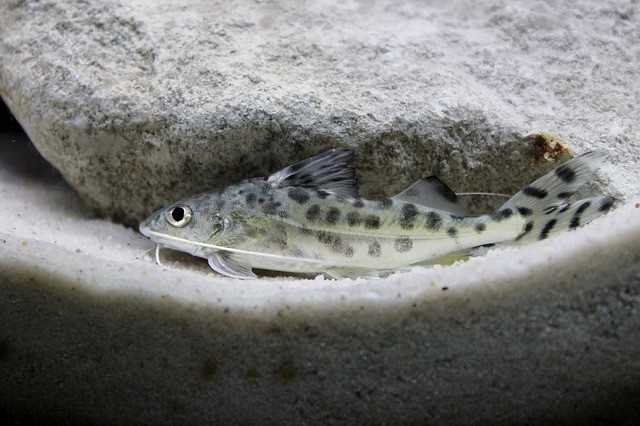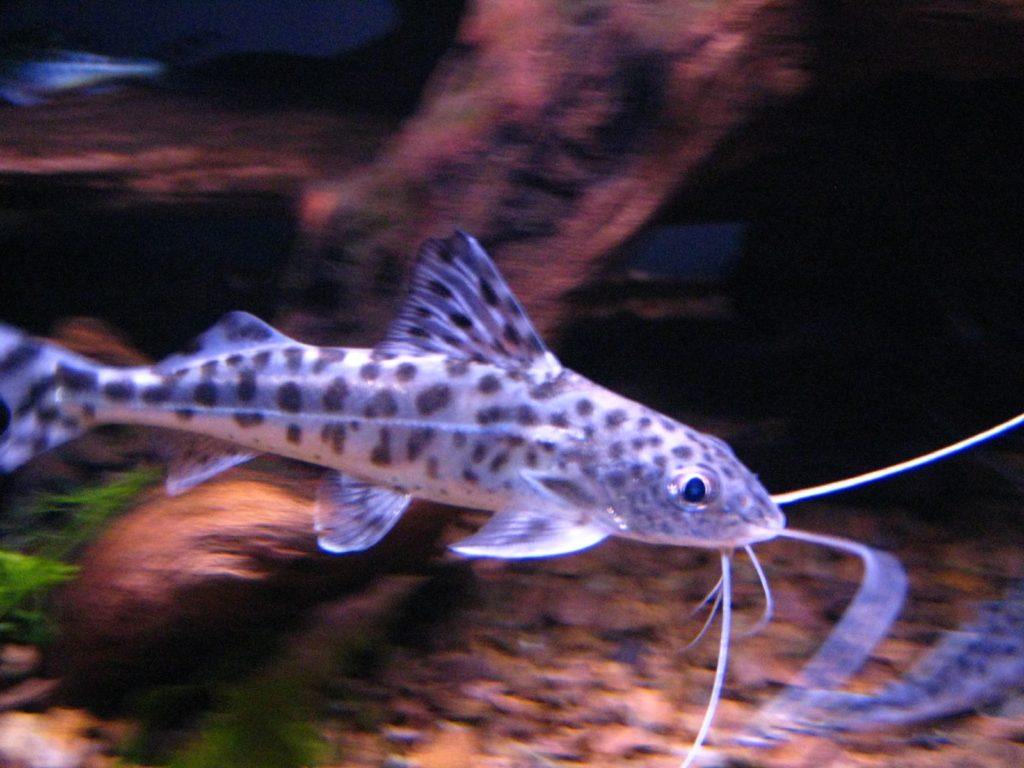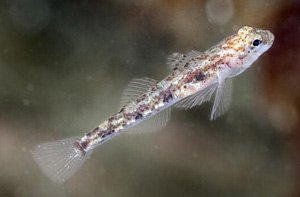If you’re interested in fish-keeping, you may wonder if there’s a ‘perfect place’ to start. Before you begin collecting your tank, filters, and food, you’ll need to decide on the type of fish to bring into your home.
There are a number of species that are low-maintenance and make excellent tank-based companions. One is the pictus catfish, which is a bottom-dwelling fish that thrives in the substrates of most tanks.

They are, in fact, one of the most common species found in home or office-based aquariums – even if they’re frequently confused with Angelicus catfish.
The pictus catfish’s unique coloring and scale-less exterior make it a curious addition to any tank. So, if this unique species has captured your heart, you’ll want to know exactly what kind of care they require.
Take into account some of the biological and environmental information listed below, and you should be able to give your new tank-based companion exactly what they need in order to thrive.
Pictus catfish care, after all, is easy to master.
Contents
Getting to Know the Pictus Catfish
The pictus catfish is also known as the Angel Cat. Because these fish are so laidback personality-wise and easy to care for, they’re one of the most popular species to keep in a home aquarium.
Pictus catfish have a unique appearance, as their white bodies are covered in black spots. They also have large barbels or whisker-like growths that extend from just above their mouths.
Many breeds of catfish have these barbels, but the pictus catfish has some of the largest in the species. These cute little whiskers come in handy when a pictus catfish needs to navigate.
The other defining feature of the pictus catfish is its sharp pectoral fins. These fins are considerably more angular than those on other breeds of catfish, so much so that they can cut through several forms of plastic and a few types of tank plants.
Natural Habitat of the Pictus Catfish
Franz Steindachner, from Austria, was the first person to identify the pictus catfish in the wild in 1876. This breed of catfish is usually found in the sandy basins of warm, freshwater rivers.

South America, and in particular, Rio Orinoco and rivers in Colombia, Venezuela, Peru, and Brazil make excellent homes for this species.
The pictus catfish thrives, though, in moving water, and can usually be found navigating in schools, even though they are perfectly successful at thriving independently.
Pictus Catfish Size
In keeping with their average nature, pictus catfish reach approximately four inches in size once they’ve matured – when they’re kept in a tank, that is.
On rare occasions, pictus catfish can grow up to five inches in length. All the same, this breed of catfish will never mature enough (when kept in a tank) to reach sexual maturity.
The details of the pictus catfishes’ breeding cycle will be discussed in more detail later on in this post, but it is worth noting that female pictus catfish are about the same size as their male counterparts.
All in all, it’s exceptionally rare for the pictus catfish to grow any larger than five inches in length.
Lifespan
Even though they are a relatively average species, the pictus catfish’s lifespan is pretty notable for its length.
These fish live an average of eight years when in captivity. This, of course, requires that they be well taken care of; because the pictus catfish is scale-less, their immune systems are weaker than those of other fish, and their needs, as will be discussed, can differ from what some new fish owners may expect.
That said, a well-cared for pictus catfish can live up to ten years in captivity, and quite possibly a few years longer.
Pictus Catfish Food
The feeding of a pictus catfish is not especially complicated. These fish are omnivores and, more frequently, scavengers.
They also have extraordinary appetites. This word is not used hyperbolically, either. Pictus catfish can eat and eat and eat, and they will rarely become full.
It’s lucky, then, that they’ve developed the capacity to eat just about anything that falls towards the bottom of their tanks.
High-quality pellets are, of course, perfectly acceptable meals for your pictus catfish. If you’re feeling more creative, though, you can branch out into live brine shrimp, frozen bloodworms, or just about any type of cut-up vegetable.
Keep in mind, though, that fish which eat a lot are likely to produce a great deal of waste. As such, you’ll want to install a filter in your fish tank that doesn’t attract your fish’s food, but which does clean up after them.
Additionally: pop culture would have some believe that captive catfish – and especially the pictus catfish – cannot solely survive by eating the bacteria on the bottom of their tanks. However, you’ll need to monitor your fish’s behavior and diet in order to find out what kind of food and feeding schedule suits them best.
It’s also worth noting that because pictus catfish prefer to stay on the bottom of their tanks, they’re less likely to eat food that floats or live food that stays towards the top of their tank. Plan your fish’s meals accordingly.
Pictus Catfish Breeding
Fish are sometimes brought into a home for more than aesthetic purposes, of course. You may also be wondering how to breed pictus catfish.
Unfortunately, pictus catfish aren’t exceptionally easy fish to breed. In fact, there isn’t much known about the ability of these fish to reproduce.
Like many freshwater fish, they tend not to do well in spawning tanks. This is, in part, because the home aquariums that pictus catfish are most frequently kept in aren’t large enough for the fish to reach the size they need to be in order to mature sexually.
In the wild, pictus catfish have an egg-based breeding cycle. The female pictus catfish will lay their eggs in sandy or muddy substrate. Then, the male pictus catfish will fertilize the eggs.
With that process out of the way, the relationship between the fish and their fry become unclear. Neither male nor female pictus catfish have any particular parental behaviors.
They’re not known for being protective of their unborn fry or, on the other end of things, eating their young or the young of other fish around them.
Here’s a video explaining more on pictus catfish.
In-Home Tanks
Now that you know a little more about the biology and habits of the pictus catfish, you can start to gather the materials you need in order to set up a healthy aquarium.
First things first: you’re going to need a tank for your pictus catfish. There are several options for you to choose from: standard tanks, show tanks, long tanks, tall tanks, and spawning tanks.
While we’ll briefly explore the details of each, it’s worth noting, in light of the pictus catfish’s erratic and little-understood breeding habits, that you probably don’t want a spawning tank if you’re intent on bringing a member of this species into your home.
Standard Tanks
For beginning fish owners, standard tanks are some of the easiest to work with, not to mention the easiest of the tanks to find.
These sorts of tanks will have lids that fit well, and they typically run between two and fifteen gallons in size.
Smaller fish, then, will do better in this style.
Show Tanks
Show tanks, comparatively, are tanks that are meant to be on display as opposed to generally kept around the home. They are considered to be made of higher quality glass or acrylic than their standard alternatives.
The lids on these tanks are also stronger than those on standard varieties, so if you bring a fish into your home that’s known to be especially jumpy or strong, then this style may be one of the best for you.
Show tanks can also be customized very easily. If you’ve had fish in your home or office before, you may have filters or toys that are left over from your previous venture.
Show tanks are flexible enough that you can reuse those materials, so long as they’ve been cleaned beforehand.
Long Tanks
Long tanks have the bulk of their measure in their horizontal axis. That is to say, long tanks are long.

This style requires particular spaces to be cleared out for them, but species like the pictus catfish will truly enjoy the amount of room that they have to swim in.
Tall Tanks
Similarly, tall tanks have the bulk of their measure in their vertical axis. They are reasonably tall – and ideal, as such, for fish who like to swim in deeper waters.
These tanks can be kept in confined spaces more easily than their long counterparts, but you may want to ensure that your ceilings are tall enough to allow for them to fit in your room of choice.
Spawning Tanks
Finally, there are tanks which are ideal for breeding. These spawning tanks have separate, specialized areas that fish can lay their eggs in, if they’re an egg-laying fish.
This separation can protect the fry, once they hatch, or the eggs themselves from external predators and bacteria.
The size of these tanks definitely helps you keep track of the new fish once they’ve hatched, and they allow the fry to mature – an important gesture if the tank mates you keep your pictus catfish with are rather aggressive.
Pictus Catfish Specifics
The ideal tank for a pictus catfish is probably a long tank. There’s more to the picking of the perfect habitat, though than tank size.
Keep in mind the wild environment in which the pictus catfish lives, and adjust the water in your tank appropriately. The pictus catfish will thrive in an environment that suits its more tropical needs.
- Ideal pH: 6-8.
- Ideal Water Hardness: 5 – 18.
- Average Tank Temperature: 71 – 77 degrees Fahrenheit.
- Average Tank Size: 55 gallons.
It’s also worth noting that the pictus catfish need to inhabit in a freshwater environment and that they live well when surrounded by driftwood or when there are caves nearby they can swim in and out of.
Their preferred sandy or muddy river beds can also be emulated by substrates placed into the tank.
It’s also beneficial to ensure that your pictus catfish tank has a tool in it that makes the water feel as though it flows. These fish tend to live in slow-moving rivers, but the point is that they’re moving, and additional environmental stimulation will suit the active nature of the pictus catfish.

Finally, and perhaps most importantly: the pictus catfish is a nocturnal species.
When you’re setting up a catfish tank, you’ll need to ensure that it’s kept in a low-lit space and that any live plants inside of it can thrive when exposed to a limited amount of light.
Pictus Catfish Tankmates
Let’s say, finally, that you’re interested in having a tank with multiple species – including the pictus catfish.
When you’re looking to create this sort of environment, you’ll want to conduct some research on appropriate pictus catfish tank mates, as well as on the attitude of the pictus catfish.
Pictus catfish are generally easy-going fish. However, their appetites are voracious, and if they get irritated, hungry, or stressed, they’ll likely eat any smaller fish in a nearby area. Pictus fish will also be prone to eating slow-swimming fish that happen to be in their tank.
Since this species is extremely active, they require a fair amount of space to move around in, so if they feel too enclosed or overcrowded, this can raise their stress levels. If they do get stressed, they’ll lash out against tank mates who they find smaller than themselves.
You’ll also want to avoid having your pictus fish share space with other bottom-dwelling species. This will cause them to feel overcrowded right away, and they may be forced to compete for food, which only furthers their stress levels.
All in all, the best sort of environment for your pictus fish is one where they’re the smallest fish in the tank.
Here’s a video showing more information on pictus fish community tanks.
Conclusion
Generally, pictus fish are a common species to keep in a home or office tank, and their relaxed attitudes will make them ideal for new fish owners.
Do you have any tips for owning pictus fish?



Do these catfish eat green algae growing on the hardscape inside a tank?